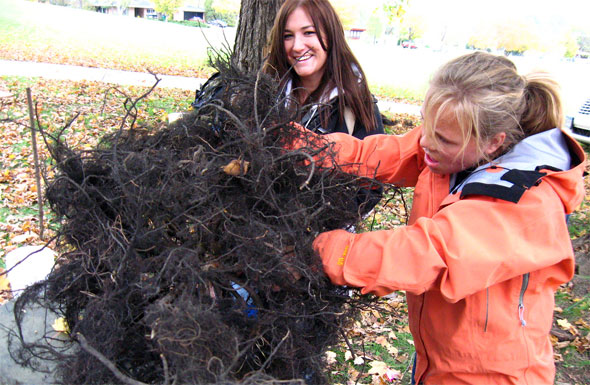The Buckthorn Menace
Unknown School) Posted November 24 2007In the mid-1800s, the large shrub Buckthorn (Rhamnus Frangula) is thought to have been brought over from somewhere in England to be used for landscaping and shrubbery. Not long after Buckthorn arrived in Minnesota, though, it started to show a strong reaction to our environment; like most species that are placed in an unfamiliar environment, the Buckthorn had a negative effect. Buckthorn spread quickly after it was introduced to the United States and, by the 1930s, the nursery industry stopped selling it. But that didn’t stop the Buckthorn. Today, Buckthorn causes numerous problems for our forests, wetlands, and prairies. It causes erosion by blocking the sunlight from plants on the forest floor and serves as a host for bugs that harm native plants. Although all of the effects are serious, each is intensified by one major problem: the berries on Buckthorn are poisonous to birds, resulting in a digestive problem which causes them to have diarrhea, eventually resulting in the seeds spreading wherever they fly, which further increases Buckthorn population.
From September 25 to October 13, 2002, and artist named Patrick Dougherty created public art display on the Carleton College campus (Northfield, MN) called “Twigonometry.” Carleton staff and students along with community members helped pull Buckthorn in Carleton’s Cowling Arboretum and McKnight Prairie. Instead of just throwing away the removed plants, Dougherty created sculptures in the shape of “nests” or “huts” using the pulled Buckthorn along with branches of Willow and Dogwood.
Now, in 2007, Carleton and St. Olaf Colleges are collaborating to combine eradicating Buckthorn and creating art with the help of the Northfield community and nature artist Jim Proctor to form the Buckthorn Menace Project.
The Buckthorn Menace began with Suzie Nakasian, co-chair of the Northfield Environmental Quality Commission, when she read an article about the artist Jim Proctor. She loved how he portrayed the Buckthorn through art. After coordinating with Proctor and the colleges, she started to sign up schools and local organizations to help make the project possible. The first to be involved were Carleton and St. Olaf colleges, followed by ARTech, the Northfield Middle School, and many other community members.

Students creating a Buckthorn head
The final products (giant “dandelions” comprised of tall Buckthorn “trunks” with heads of Buckthorn roots) were built by the community in three steps. The first step was for people to sign up for a specific time every week that they could commit to working on the project. The second step was, of course, to pull Buckthorn. You would visit either Carleton or St. Olaf at the time you had previously arranged and pull/trim buckthorn with the help of Jim Proctor and others. The final step was to construct the head. First you would sort the buckthorn roots by size, then you would attach the roots to round balls made of buckthorn. They were randomly spaced around the Carleton Arboretum and St. Olaf as public art for everyone to see and experience, and will be left there for one more year then replaced by native trees and bushes.
Hopefully, this project will enlighten the community about the environmental danger close to home and how we can come together to put it to a stop.